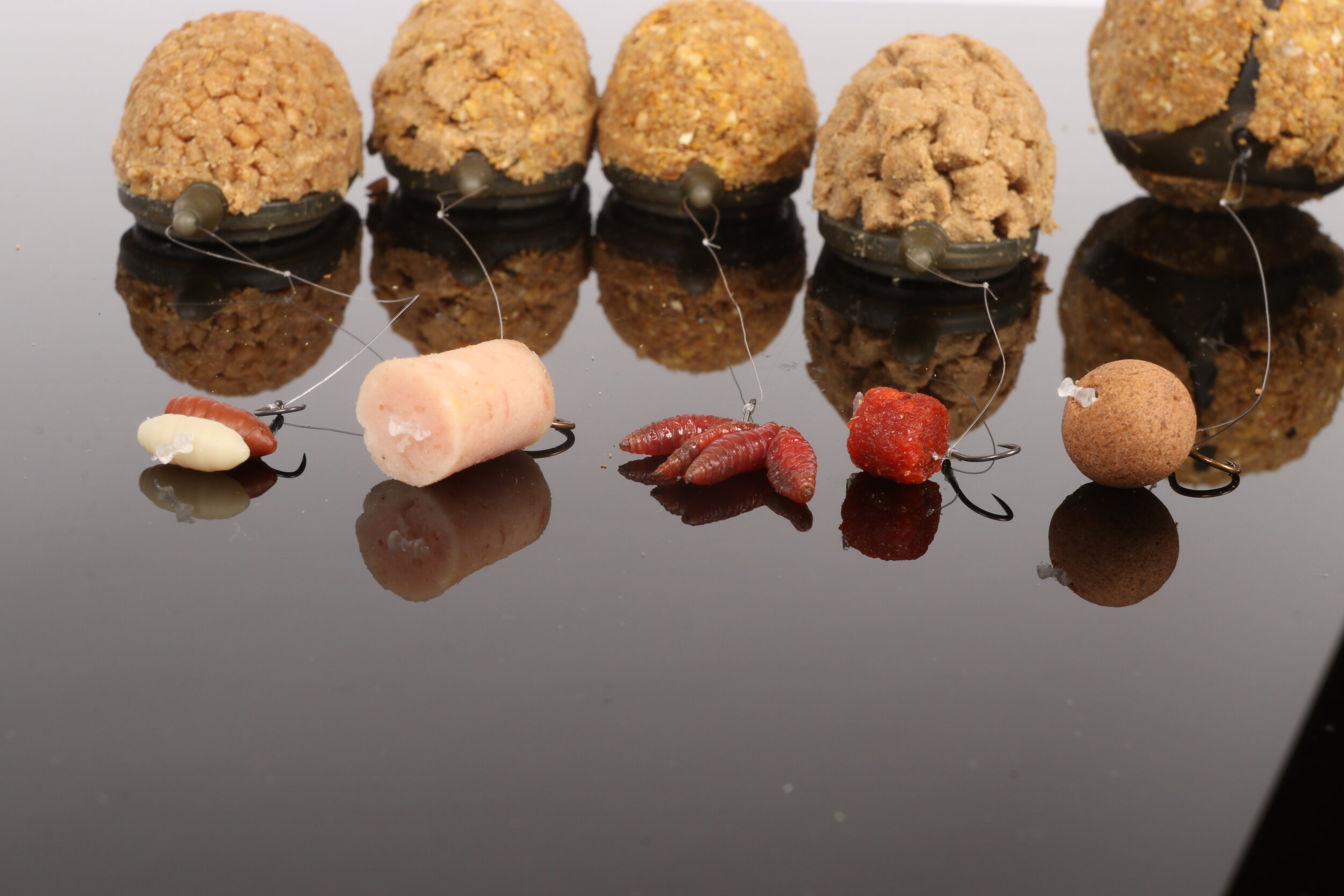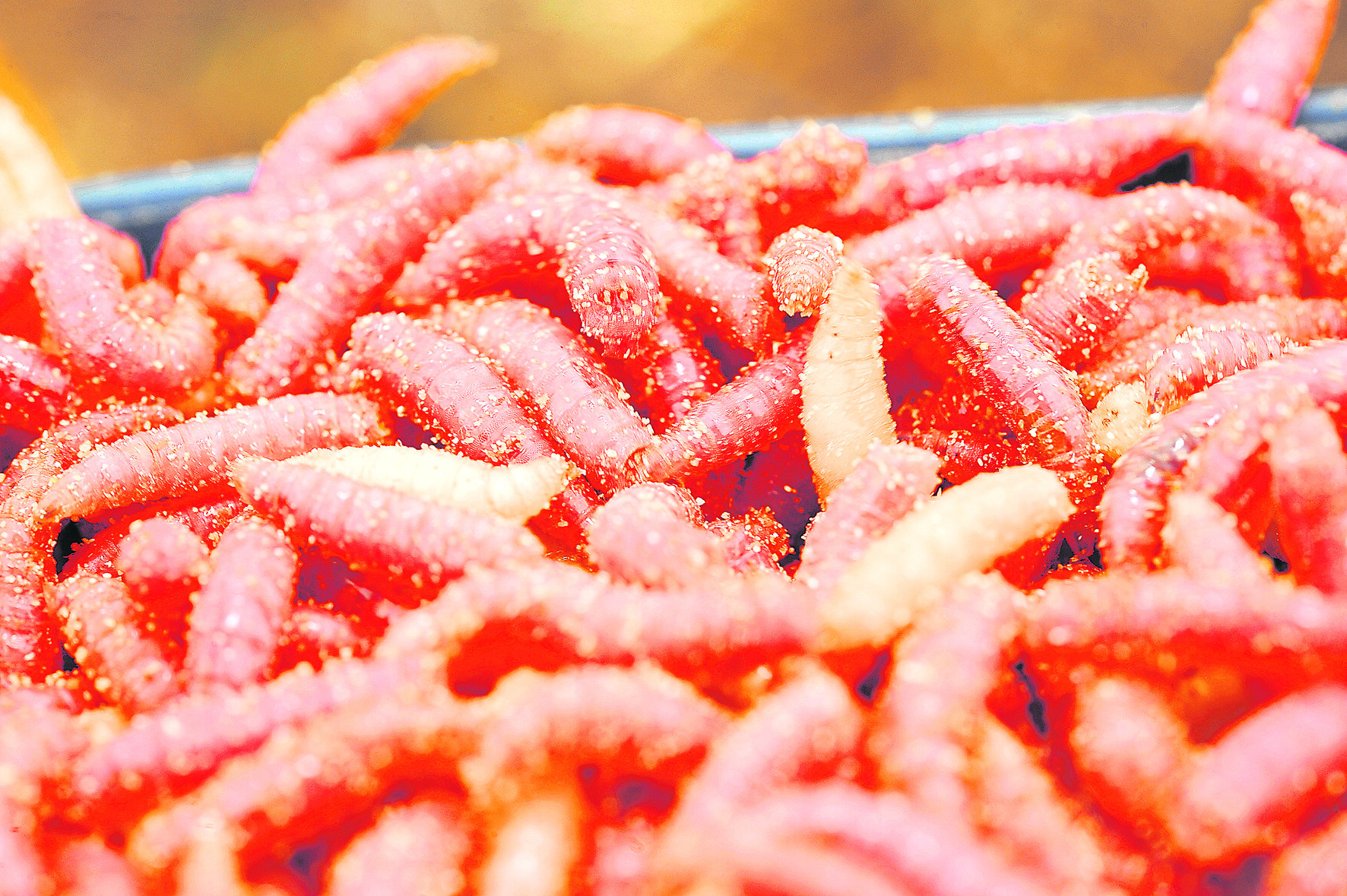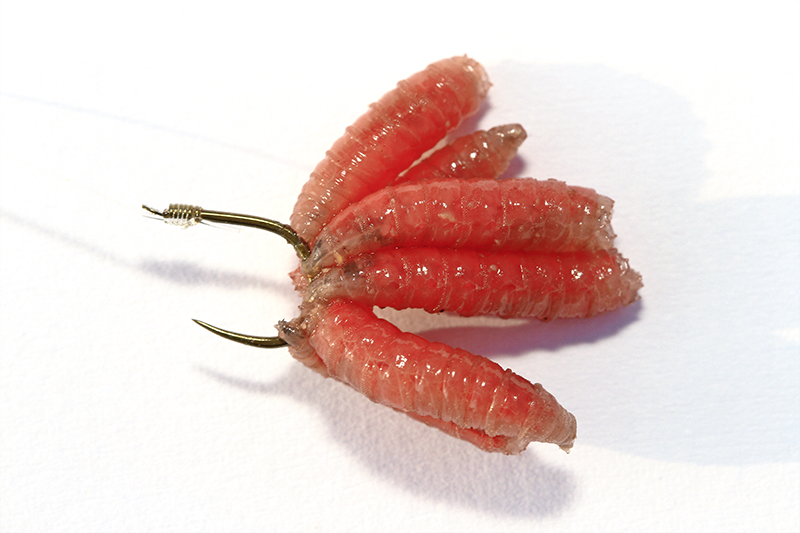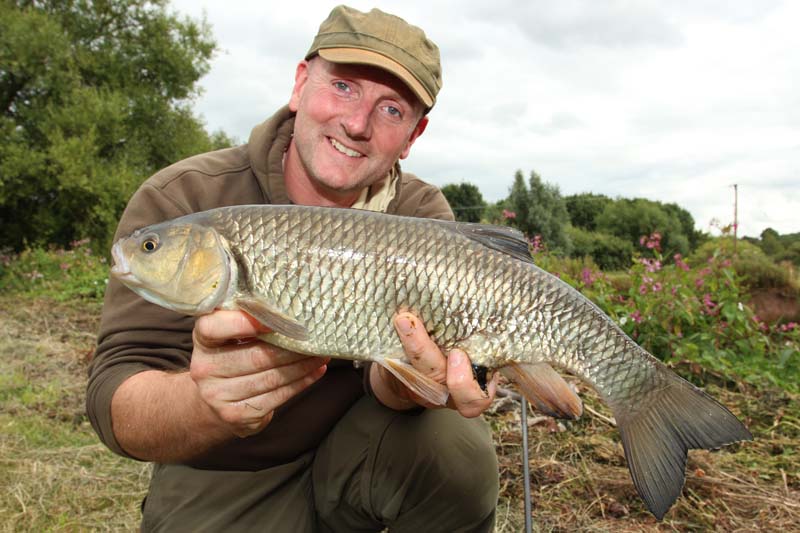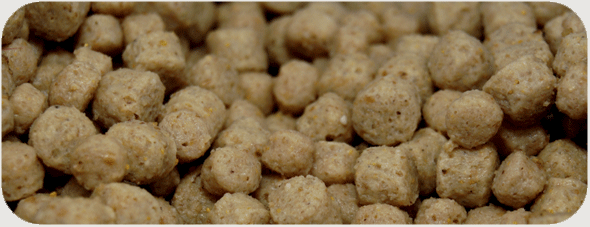Dr Paul Garner's 10 minute make | Preparing micro pellets
Micro pellets cannot be prepared in the same way as pellets of a larger diameter, simply by soaking or pumping – try to do that and they will quickly turn to a mush.
Instead, you have to add water a little at a time, allowing time for the micros to absorb moisture but never become saturated. You can add liquid flavouring to the mixing water (right) and for an extra ‘kick’ try a teaspoonful of rock salt sprinkled over the prepared pellets.
Add a teaspoonful of Cappuccino flavouring to a pint of lake water and mix well.
Slowly add some of the water to the micro pellets in a shallow mixing bowl. The pellets should soak up the water immediately.
When the pellets start to become tacky, leave them for five minutes so they are able to start absorbing the water.
Carefully add a little more water until the pellets are quite tacky but are still absorbing water.
Sprinkle a teaspoonful of rock salt over the pellets to give them an extra boost.
This is what the finished setup looks like!
Spice up your zig rigs this spring!
Give your zig rigs a makeover this spring with bait expert Dr Paul Garner, by following his spring tweaks for suspended baits.
You’d think that longer days and a hint of warmth in the sun’s rays would see carp catches soar. Trouble is, often the conditions flatter to deceive and many a time I’ve returned been frustrated by my lack of success in circumstances that looked perfect.
Yes, my swim choice may have been spot-on, but my baits were several feet below the carp. These fish spend a lot of time up in the water all year, but bright sunny days will see them anywhere from half-depth to just below the surface. You might see tell-tale black backs lifting slightly above the surface.
Also look out for fly hatches - waterfowl congregate to gorge themselves on this easy meal and the carp won’t be far behind. So what’s the key to unlocking these conditions? Zigging, of course!
Real bait zigs
If your local venue doesn’t allow the use of artificial baits, or you simply have more confidence in using a ‘real’ bait, my advice would be to get hold of some small marshmallows from the baking section of your local supermarket.
These soft, super-buoyant baits are just the right size and can be hair-rigged or side-hooked. On a size 12 hook and 0.20mm line a marshmallow will support up to a 6ft hooklength. Longer than this, and the extra buoyancy of an artificial bait is more effective.
Artificials
Carp are inquisitive creatures. Watch them up close and you will notice that they will sample anything even slightly edible that is put in front of them. This goes just as much for bits of cork and foam rubber as it does for intricately crafted Zig Bugs. A small piece of black foam is, for many hardened carpers, the only zig bait they use, but I think it can pay to ring the changes.
Changing the colour of the foam, or swapping to cork, can bring extra bites when black is not producing. Zigs are mainly about visual appeal, so using a bright colour can make the bait scream ‘eat me!’. Movement can also be added to a zig simply by impaling a maggot or small worm on the hook. It is surprising how much the wriggling moves the bait around, giving it extra appeal that will last for an hour or more.
I prefer Zig Bugs over straight foam for much of my zig fishing, but not because they resemble any of the carp’s natural diet. I like the fact that the dressing on a Bug disguises the hook, making it less conspicuous. Hook and bait as one also leads to better hookholds than with a hair-rigged bait.
Sold on flavours
A few years ago now I spent a day on the bank with a match fishing friend trying out different zig baits, and the results were quite astonishing. In particular, we were interested in whether flavouring the baits could make a difference. It was a particularly tough day, but we managed to winkle out half-a-dozen carp, every one of which fell to a marshmallow dipped in dilute flavouring.
This is hardly conclusive proof, but it has persuaded me that there are no disadvantages to using flavoured baits, and just possibly they can make a positive difference. The best flavours are those that disperse quickly and rise through the water column. Ester-based flavours, such as pineapple and strawberry, are particularly effective and I will give my hookbait a quick dip in these before every cast.
To feed or not to feed?
Whether to feed anything when fishing with zigs is a tricky question at this time of the year. In the height of summer on a prolific venue I’d have no hesitation in mixing up a bucketful of very sloppy ‘spod soup’ and raining down a cloud of bait over my hookbaits. The splash of the spod actually attracts carp when they are ‘up for it’. On all but the most prolific venues, though, I tend to be much more cautious right now and leave the spod rod at home.
That said, pinging a few 8mm slow-sinking pellets over your suspended hookbaits can work. The pellets will sink, ending up several feet below the hookbait, so there is little risk of overfeeding, although you might draw some of the carp down to the deck.
Six pellets every 10 minutes is enough to evoke a reaction if the carp are willing to respond to the pitter-patter of pellets going in.
Steve Ringer's top 10 baits to use when fishing commercials.
Are you looking for for an edge when it comes to being on a commercial fishery? Then follow match ace Steve Ringer's top 10 baits that he uses when fishing for carp on a commercial as these tips will give you the advantage that you need.
1) Margins – big baits means more bites
When fishing in the edge, one of the hardest things is getting a carp to pick up your hookbait, especially when a lot of them are feeding. I would go as far as to say there is nothing more frustrating than being able to see carp in the edge and then not be able to catch them. This is where a big ‘target bait’ such as 10-12 dead red maggots really comes into its own.
If you think about it there are going to be lots of maggots on the bottom so if I fish just two or three on the hook it’s going to take a while for a carp to find them. Fish a bunch, however, and bites can be instant! That’s how much of a difference it can make.
2) Blow up your pellets
A few years back I was doing a lot of straight lead and pellet fishing but always felt I was missing an edge over other anglers who were fishing the same tactic. Then one day when I was packing up I noticed a few pellets had fallen under my seatbox. What struck me was the size of the pellets – they had taken on water and were almost twice the size.
This got me thinking as the same thing had to be happening in the water once the pellets had been on the bottom a while. I therefore decided to pump some hard 8mm pellets and leave them in water so that they ‘blew up’ into massive, soft pellets.
Once I got the process of prepping the pellets rightthe results were staggering and I was getting more bites than ever before on my ‘new’ blown pellets! I had found the edge I had been looking for and ever since that day when lead and pellet fishing I always have a few ‘blown’ pellets with me.
3) Hard pellets - noise is the key
When the fishing is hard and there isn’t a lot happening I am big believer in trying to draw a few fish into the swim and the best way to do so is to make a noise with hard pellets. I pick up my catapult and ping just 3-4 pellets on top of the float every 20 seconds.
The reason this works is that carp home in on the noise of the pellets hitting the water but at the same time I’m not putting lots of bait on the bottom and risking killing the swim. Size-wise this tactic works best with either 6mm or 8mm pellets because anything smaller doesn’t make enough noise to help pull a fish or two into the swim.
4) Coloured water equals red meat
I love fishing meat but it loses its effectiveness when the water is extremely coloured. When this is the case I will take a handful of my 6mm cubes and dye them red. The reason being when the water is very coloured red offers a strong silhouette and gives the carp a bait they can really home in on.
I was always sceptical about red meat in the past but I’ve had good results using it too many times in coloured water conditions for it to be coincidence. I use Ringers Red Liquid to dye my cubes and will only dye my hookbait meat and not the cubes used for feeding.
5) Foul-hooking? Hemp is the answer
I’m often asked how to prevent foul-hooking carp when fishing meat close in?
My answer is to use hemp. But, and it’s a big but, it has to be used in the right way. If you feed it little and often along with the meat then there is a danger the carp can get preoccupied on it and you won’t be able to catch them.
It’s much better to use hemp purely as settling bait. So at the start I will pot in two thirds of a large 250ml Drennan pot of just hemp to form a bed. Then if I start to catch a few and then start to suffer from foul hooking, I will simply introduce another big pot of hemp to settle them back down again.
6) Feed heavy close in to get out of jail
Every now and again in a match you need a get- out-of-jail card and, while most people use the margins for this, I prefer to fish short on a top kit straight in front of me. I mix hemp, corn and meat and simply lash it in to create the impression of someone packing up and throwing all their bait in.
I normally kick the swim off with three big handfuls of bait and go straight in over the top because quite often I will get a quick response from a fish within seconds. From that point on I will keep lashing the bait.It’s an approach that doesn’t always work but it has paid off on many occasions for it to be my ‘go to’ line when things aren’t going to plan.
7) Pack in the particles for bream
The secret to building a big weight of bream is particles particles – casters, pellets, worms etc. I pile in the particles in the first hour to put a bed of bait on the bottom. To do thisuse a bigger feeder and cast more often. Then when the bream turn up, perhaps 90 minutes in, I have a lot more bait on the bottom to hold the bream for longer.
8) Corn – two grains are better than one
Sweetcorn is a fantastic bait all year round but it’s particularly effective at this time of year. The interesting part about corn is that when it comes to fishing it on the hook then I always tend to find that two grains are without doubt better than one.
Loads of times I have caught on corn and alternated between single and double on the hook only to find two grains constantly produced quicker bites and bigger fish. There are two possible reasons for this, firstly the bigger bait stands out more over the loose offerings so the carp spot it that bit quicker, or it could be that everyone tends to fish a single grain of corn so two grains gets treated with less suspicion.
9) Stand out or blend in?
When fishing the Method or Hybrid feeder there are loads of different hookbaits you can use but I like to simplify things by dividing them into two camps, blend-in and stand-out. Blend-in baits are those such as hard pellets that match the pellets on the feeder. When the fishing is hard this type of bait takes some beating.
The reason for this is that when the fishing is hard there aren’t many fish in the swim so those that are there can afford to be picky about what they pick up. Hence a blend-in bait works well as it can trick even the wariest of carp.
If, however, there are loads of fish in the swim then stand-out baits such as mini fluoro boilies or bread really come into their own. These work because they are highly visible and give the carp something they can really home in on.
10) Give your meat a double cut
A couple of years back I spent a lot of time at Tunnel Barn Farm fishing meat into the shallow water across to far banks and islands. The problem was I struggled to hold the fish in the swim for long periods when feeding 6mm cubes.
What I needed, of course, was to create a cloud to firstly draw the fish in and then hold them in the swim once they arrived. To achieve this I decided to create a meaty mush by passing around a third of my 6mm meat cubes back through the cutter again, giving myself a feed made up of different sizes which almost exploded on the surface of the water.
This was added to 8-10 6mm cubes in my pot so when it was fed the cloudy mush pulled the fish into the swim and once they arrived they followed the 6mm cubes down to the bottom so I could catch them!
How to give your maggots and pellets the edge they need!
Maggots and pellets are without doubt the top springtime baits on commercials, but could the deadly duo be made even more effective? You bet!
Gallons of each are piled into our favourite fisheries and while bites are almost assured when using them both, your catch returns could be given an even bigger boost by making a few simple yet underrated tweaks. Maver-backed matchman Jake Robinson has been almost unbeatable in recent months, scoring numerous victories in competitions that have been contested by some of the country’s biggest stars.
Rather than apply tactics straight from the textbook, the Staffordshire-based rod has dared to be different and that bold approach has served him well time and time again. “Flavourings are often dismissed but I’ve worked on four different combinations that will work wonders at this time of year when big nets of carp, F1s and silverfish are in mind.”
“By giving my maggots and pellets a colourful and flavoursome edge, I’ve been able to keep the success coming, even when I’ve found myself on pegs described as were no-hopers.”
1) Luminous maggots
Red maggots are the number one choice of thousands of anglers, but could you make them even redder and increase their pulling power? “Red maggots straight out on the bait box aren’t particularly vibrant and I’ve found that adding a bright red liquid to them has several benefits.”
“First of all it makes your hookbait and loosefeed stand out a mile in clear water and the cloud also lingers to draw in fish that would be unaware of the feast waiting for them.” A whole bottle of Bag’em Matchbaits Red Aggressor liquid is added to two pints of maggots the night before a session, swilled around and then left to rest overnight. By the morning your bait will stand out a mile!
2) Pineapple pellets
There is an obsession with fishmeal products on commercials but going the other way and using a very sweet flavouring or additive can often score heavily. “Fish stocks have become accustomed to fishmeal and I think doing something different with your pellets helps attract the wary and often bigger fish into feeding confidently.”
Rather than dampen your micro or 4mm pellets with water, slowly add Pure Pineapple liquid and mix it in. Once all the bait is thoroughly soaked, place the bait lid on, leave to settle for 15 minutes and you’ll then have softened pellets with a difference.
3) Blood red expanders
There will be some days when no matter what you try, you just can’t convince the fish to feed. During those sessions, it is key to make sure that the fish notice your hookbait quickly and don’t fill themselves on loosefeed. “I often feed normal micro pellets and place a vibrant and unmissable target bait on top of that. A blood red expander is much better than anything else in my experience.”
Pump your expander pellets as you normally would and then sprinkle a teaspoon of Super Sweet Meat and Maggot dye over the top. Place the lid on the tub, shake for 30 seconds and you’ll then have blood red expanders that no commercial fish will be able to resist.
4) Yellow micros
When you are fishing in shallow water up against an island or the far bank of a snake lake, it can pay to introduce a colourful cloud. Introduce a couple of spoonfuls of yellow Super Sweet Meat and Maggot dye to your loosefeed. Don’t mix it in too heavily, keeping the powder visible.
“Each time you feed, a small amount of powder will be introduced neat and that creates a cloud that lingers in the swim. Red and green are common colours on commercials but yellow is underrated and as fish don’t see it that often is the reason it is so effective.”
Best coarse fishing hookbaits to be using right now!
Tommy Pickering gives his opinion on the best hookbaits that you should be using right now if you are wanting to catch consistently.
The rise in temperatures in recent weeks has stirred fish stocks into feeding, but careful consideration still needs to be given to your bait choices if you are to succeed. Pick the wrong hookbait and there’s every chance that your target species will ignore it and leave you struggling for action. If I had to pick five baits to see me through the next few weeks, these are what they would be...
Casters.
These pick out the biggest silverfish in the shoal – the orangey-brown ones are best. Double and single caster works on a size 16 or 18 hook when roach and skimmers are the target fish.
Pellets.
Fish consider these their main food source. Hard pellets in a bait band score on bomb, waggler or pole for quality carp and F1s. Soft expanders are a better option for bonus tench and skimmers.
Meat.
In winter this can be fantastic on the bomb for commercial carp and F1s or river barbel. I push a tin through a meat cutter to create 6mm or 8mm cubes. Avoid cheap, fatty brands that tend to float.
Maggots.
Maggots tend to attract small fish to start with but bigger bonus fish may then move in. Dead maggots are extremely effective when used as a hookbait on the Method feeder.
Sweetcorn.
In clear water, a grain of corn stands out a mile. Use it on the bomb on a size 16 or 18 hook when casting around to find a shoal, or loosefeed it sparingly on the pole line through a small cup.
Hair-rigging pellets using the lasso method
There are many ways to hair-rig hard pellets, but some of these methods require a drill or a bottle of Superglue. But what happens if you don't have either of those things? What do you do then?
It's actually possible to tie a large halibut pellet onto a hook hair, using a neat lasso formed from your hooklink material - and that can be either mono or braid - either will do the job effectively.
If the hooklength you are using happens to be a coated braid, you'll need to strip back quite a lot to enable you to tie your pellet on effectively.
So, here's how to tie it in eight simple steps...
1. Make a loop in your hooklength, you’re going to tie a grinner knot
2. Thread the end through the loop.
3. Make sure you pass it through at least four times.
4. Tighten down the loop - but not too far!
5. Slip the pellet into the noose you’ve created.
6. Trim off the tag end with a sharp pair of scissors.
7. Using the knotless knot, attach the hook.
8. Using another grinner knot, attach the swivel. The rig is now finished.
Barbel fishing with pellets
Halibut pellets have totally revolutionised barbel fishing. On a nutshell, catching big barbel on halibut pellets is THE number one river method right now.
Britain’s barbel have become besotted with these potent pellets, in the next few months they will probably account for the capture of more fish than any other bait.
According to River Severn barbel expert, Jason Ford: “Barbel are a passion of mine and the Premiership bait for them is the halibut pellet,” he said, casting a swimfeeder stuffed with pellets across the waterway.
Placing his rod into an extended rest, pointing slightly downstream, his eyes focussed on the curved quivertop rod.
His feeder, stuffed to the gunnels with a mixture of different sized pellets, was emptying its payload into the muscular current.
Jason had set up just above a fast section of water at the base of a steep wooded gorge, where speedy currents were whipping alongside slower, slacker water.
Jason’s plan was to land tempting morsels of bait right near the barbel, lazily residing in the gentler flow.
From this ambush point the barbel shift across the fast water to intercept food items washed down the river by the flow.
Normally, as a starter, a washed out worm might whet a barbel’s appetite, followed by a watersnail as a main course with a caddis larvae as dessert.
Hardly hugely appetising grub it must be said!
It’s no surprise then, that when more appealing culinary temptations are available that the barbel’s menu is swiftly changed.
Enter those tasty, oily, calorie-packed treats in the form of fishmeal-rich halibut pellets.
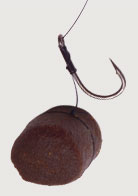 Whenever barbel are talked about, textbooks from just five or six years ago put meat, corn and maggots up there as the top barbel baits and certainly they’ll still catch their fill of barbel.
Whenever barbel are talked about, textbooks from just five or six years ago put meat, corn and maggots up there as the top barbel baits and certainly they’ll still catch their fill of barbel.
But the pellet revolution is a 21st century trend that keeps growing. Amino acids, the building blocks of proteins, are packed into pellets and are adored by barbel.
“I’ve always loved fishing for barbel,” said the Kidderminster and District AA Bailiff.
“My first barbel was a tiddler from Shrewsbury weir that I caught with maggots 40 years ago.
“You can still use maggots, but for attracting lots of barbel you just can’t beat halibut pellets.”
FAITH IN THE PELLET
Set up on Kidderminster DAA’s piece of the Severn, just above Bewdley in Worcestershire, it was instantly clear that Jason had set out on a pellet-only attack, such was his faith in the bait.
“Barbel use all their senses to search out food,” he explained.
“Like many anglers I used to be a luncheon meat man. When I saw a good match angler, called Matt Hamilton, win a match on the River Wye with 50lb of barbel three years ago on pellets I was bowled over.
“My technique of presenting pellets on the feeder is simple, and absolutely anyone can follow it for success.
“I’ve used it countless times in the last couple of seasons and I tell you, it’s won me plenty of matches too,” he said in his friendly Black Country accent.
After just 20 minutes, Jason’s rod shivered, then hooped round in as a barbel took his hair-rigged pellet, foolishly thinking that the hookbait was another free meal pushed out of the feeder by the current.
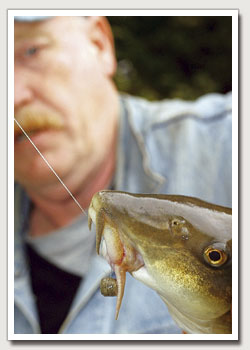 Bending his 11ft 1.75 test curve Normark Avon rod into the fish, the barbel surged off in search of a refuge in which to lose the hook.
Bending his 11ft 1.75 test curve Normark Avon rod into the fish, the barbel surged off in search of a refuge in which to lose the hook.
This peg, Jason assured me, was a snag free swim, except for a nearside bush leaning out into the water, and reaching out into the river Jason managed to turn the away from the branches.
His tackle was perfectly suited for the job, it was strong enough without being over-gunned, and after an enjoyable battle on a responsive rod, a pellet-scoffing 4lb fish was guided into the welcoming folds of his net.
SEVERN HEAVEN
With his first fish of the day safely landed Jason didn’t waste anytime recasting his pellet-loaded feeder.
As he explained, when you are relying on the potent smell of a bait to attract fish to your swim, it is essential that you use a rhythmic casting technique to inject pellets into the water.
Every 10 minutes he retrieved the empty feeder, filled it up again, and recast it into mid-river.
As he waited for the next pellet muncher to invade his swim, Jason explained the attraction of barbel on the Severn: “This is a barbel angler’s paradise,” he enthused.
“A hooked barbel is like an Exocet missile on string - the excitement and sport they provide is unique in angling.
“That’s why I’ve been living on the banks of the Severn for the last 30 years!
“It’s a river that’s well worth visiting, wherever you live, simply because of the numbers of barbel.
“There’s so much variety in the pegs. There are deeps, shallows, narrow runs and wide stretches like this peg, nicknamed the Nursery, as you find lots of juvenile barbel among the three and four pounders.
“Plus there’s always the beauty of nature to take in too!”
Proof of this final point was promptly echoed as we watched the iridescent flash of a kingfisher dart across the river.
For the price of a £3 day ticket this rivals any commercial pool for enjoyment!
TACKLE AND KIT
Feeder fishing for barbel is an uncomplicated affair. A medium to heavy feeder rod, that’s also suited for commercial carp work, fits the bill if you match it with a large fixed spool reel loaded with 8lb line.
His rig is a simple running set up, using a Dinsmores block-end feeder.
These feeders are brilliant at depositing various-sized pellets into the swim as they are robust and withstand repeated casting.
Jason enlarges the feeder’s holes by carefully twisting sharp scissor blades in them, this allows the pellets to have a quicker exit.
Using a clip on swivel (see diagram below), the feeder is left free running above a small fixed swivel carrying a 15 inch long hooklength of 8lb Terry Eustace Pro Gold line capped with a Mustad Eyed Specialist size 14 hook.
It was strong gear that was perfectly matched to the power of the rod.
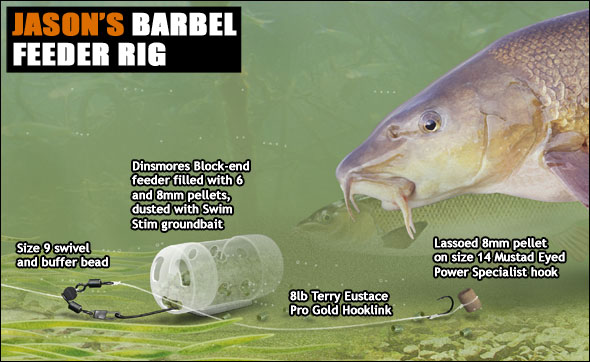
BAITING UP
If you’ve fished with pellets before you’ll know that drilling them, especially the small 8mm ones Jason uses, can be a thankless task.
All too often impatience means that they break up before you’ve finished drilling them.
However, instead of this fiddly task, Jason has come up with an ingenious loop system that lassos the bait firmly and securely in place.
Jason starts by tying a grinner knot at one end of the hooklink.
Then, before the loop is closed, the pellet is popped into the ‘noose’ which is tightened down to grip the bait.
Next, using a knotless knot, the lassoed pellet is attached to the hook. Another grinner knot is used to tie on the other end of the hooklength onto the swivel.
When it comes to rebaiting, it’s a case of using a pair of scissors or the nose of a pair of pliers to tease open the loop containing the pellet. Push in a fresh pellet, pull the loop tight and you’re ready for action again!
On a low, slow flowing river in summer, pellets can be introduced by hand, but in the autumn and winter, when the extra pace of the river would carry pellets in all manner of directions, the feeder is the most accurate way of introducing feed.
“If you fill your feeder with just pellets, one problem you can get is that they explode out of the feeder too quickly,” revealed Jason.
“The solution is to dust the pellets in Dynamite Baits Swim Stim groundbait.
“This binds the pellets together just long enough to ensure they remain in the feeder until it hits the bottom, when they’re released, right next to your identical, pellet hookbait.”
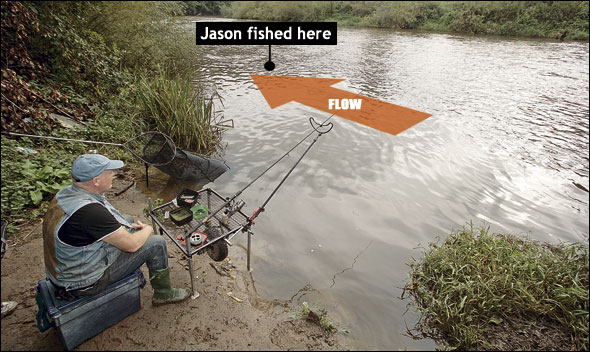
GLUG AWAY
“Barbel have great senses, both in terms of sight and smell,” said Jason.
“As a smoker I’m wary of tobacco on my fingers tainting my hookbait, I disguise this by glugging my hookbait in a bottle of Dynamite Baits Halibut liquid flavouring. It also provides an extra flavour trail.”
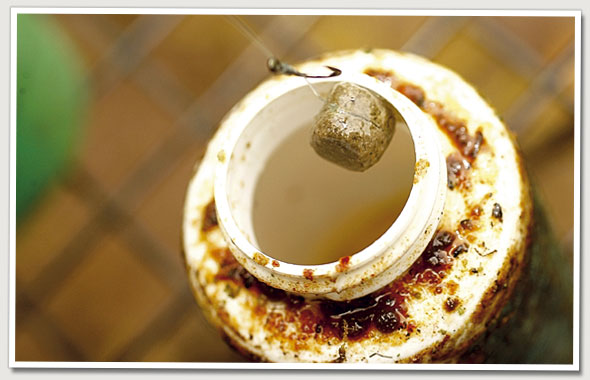
BARBEL LOCATION
Having spent over 40 years fishing the Severn, Jason knows the sort of features that make a good peg.
There are key characteristics he looks for if he’s pleasure fishing: “The first thing I look for is pacey water - flowing at least at walking speed - where there’s plenty oxygen passing through their gills.
“I look for a glide, running over small rocks or gravel.
“In summer, when you have lower flow, I’ll be looking areas of faster flow, that you’ll find on the outside of bends and where the river narrows.
“In the next few winter months I’ll be looking for easy glides offering a constant push of water.
“Boiling water, where the river is eddying around, should be avoided, barbel don’t like to have to keep constantly adjusting to a variable current.”
THE SESSION
Quickly following up with another 4lb barbel, Jason explained his options for the remainder of the session.
“I could cast slightly upstream or downstream of my baited area. It’s a big river and sometimes you have to move your bait to find the fish again,” he said.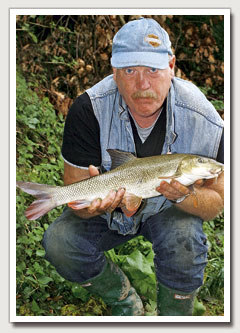
“The next possibility is to drop down in hooklength diameter and hook size. This is an option that definitely gets you more fish, when they’re not feeding properly and things are quiet.”
Following a half-an-hour lull in action, Jason duly switched from his 8lb hooklink to a 5.5lb bottom and dropped down a hook size to a number 16 Mustad Eyed Specialist.
“The reduction in hook size and line diameter may seem insignificant in a coloured river, but this has brought so many extra fish in the past that it’s always worth a try,” Jason revealed.
“Barbel are sophisticated feeders and will spit out a hookbait they are suspicious about extremely quickly.”
With his fined-down tackle Jason cast again over his baited area.
Almost immediately the quivertip rattled: “That’s a chub mouthing the bait. Just like if you’re were bream fishing, you only strike at full blooded lunges,” he advised.
We sat expectantly watching as the rod trembled once more, before lurching over again in a violent hoop.
This time, with the slightly lighter hooklength, Jason played the fish with a tad more care but he soon slid the net under the fish, soon followed by a bonus 3lb chub.
GIVE IT A GO!
“Fishing commercial waters is great, but if you want to broaden your experience then the excitement of barbel fishing just has to be tried,” said Jason.
“If you haven’t given it a go, get down to your nearest barbell river, arm yourself pellets and you’ll be hooked just like I am,” he urged.
“When you get that first flash of barbel pulsing and battling on the end of your line you’ll be going back for more and more, I promise you that!”
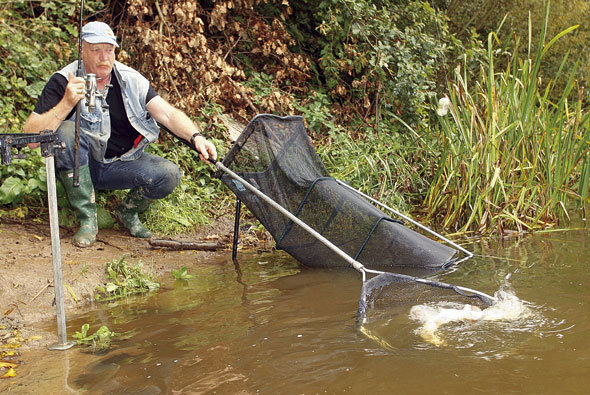
Types of fishing pellet explained
Unlike men, not all pellets are created equal. Some have high oil content, some have low oil content, others break down and some are flavoured. Which one you pick depends on the job you want it to perform. To remove confusion, here’s a selection of the types of pellet and how they work.
1. Halibut
These high-oil pellets are crammed with nutrients and proteins. Available from tiny 2mm pellets used to create beds of free bait, through to gob-stopping 21mm giant pellets. They are often glued to a hair rig, or drilled and threaded on a hair. Big carp, barbel, catfish and specimen bream and chub love them.
2. Carp
Many commercial fisheries have banned halibut and trout pellets due to their high oil content. Based on vegetable proteins, these pellets are less oily, but are still excellent carp attractors. They tend to break down rapidly and are best used as a loosefeed, rather than a hookbait.
3. Trout
Primarily created from salmon fry crumb, trout pellets have very high oil and protein content. Because of this, they’re better in summer when the warmer water will wash the oil out of the bait and create a scent trial for the fish to home in on.
4. Expanders
These hard, buoyant pellets are designed to be soaked in water to soften them and produce a slightly spongy texture. This enables you to directly hook the pellets. Jamie Masson uses BCUK pre-soaked expanders for his hookbait.
5. Hemp
There are few freshwater fish that don’t love hemp. These pellets are designed to breakdown completely into a hempy mush. Being fairly low in oil, they’re ideal to use all year round. They work well in PVA bags, groundbait mixes, as a loose feed or can even be boosted with a little hemp oil. Tremendous for tench and carp.
6. Soft feed pellets
Usually made from tiny carp pellets that have been carefully moistened and preserved. Excellent for getting carp and silver fish feeding and keeping them in the swim.
7. CSL
CSL stands for Corn Steep Liquor. These savoury smelling pellets collapse quickly underwater, creating a fine carpet of attractive food particles. They can be used in PVA bags or Method mixes, they’re also good when used as a loosefeed. Many species love CSL, particularly carp and barbel. These are sweet pellets.
8. Flavoured pellets
Bait companies make customised fishmeal or carp pellets laced with flavouring. These are Nutrabaits Trigga Ice pellets, big carp love them.
Preparing and flavouring expander pellets using a pellet pump
Most expander pellets float if they are used dry, straight from the bag. To make them sink, so you can use them to catch carp, bream, tench and crucian carp, you will have to prepare them correctly. That means using a pellet pump.
Pellet pumps come in all shapes, sizes and colours, but they all perform exactly the same function – to remove air from the pellets and replace the air with water. That’s what makes the pellets sink.
But did you know that you can flavour your pellets too, to make them even more appealing to the fish? You can flavour them while using the pellet pump. Here’s how to do it…
1
2
3
4
5
1. Tip the amount of pellets that you need for your session into your pellet pump. Now fill the pellet pump container with enough water to ensure that all the pellets float.
2. It is at this stage that you add a squirt of your chosen flavour, if you so wish.
3.Now securely attach the pump to the container and pump it 10 times. Now release the lid to allow the air to escape and re-attach the top and pump it 10 times again. The pellets will now have sunk to the bottom of the container.
4. Once they have been pumped, the pellets can be tipped out over a sieve or riddle and transferred into a clean bait box. Now, to keep the pellets fresh and to stop them from drying out, tip just enough water over the pellets to cover them.
5.Some match anglers prefer to prepare their pellets on the bank immediately before they begin their match or session, but you don’t have to do this. You can prepare the pellets the night before, tip them out to drain them and immediately bag them up. Squeeze the bag to remove any excess air, twist the neck, seal it and store in a fridge overnight.
Pellets – the perfect fishing feed and bait
Pellets were originally created as an animal foodstuff or as a feed for stocked fish. The pellets were used to ensure that the animals and fish gained substantial weight prior to being sold to market. But anglers have latched on to these protein-packed food morsels and have discovered just how good they can be for attracting quality fish like carp, tench, bream, catfish, barbell and chubinto their swim.
They are produced by extruding. Basically the raw ingredients such as fishmeal and vegetable matter are mixed and forced through small tubes (called extrusion). This creates a sausage-like tube of the mix. This is then heated with steam to harden the mix. The final stage it to cut the cooked mix into the desired length. And that’s how they make pellets.
Luckily for all you carp, barbel, chub and catfish anglers out there, the large 21mm and larger halibut pellets needed another heat source to ensure that the centre of the pellets were cooked and harden. The only way this could be done was to force steam into the middle of the pellet, and that’s why some larger pellets were already supplied with a perfect hole in the centre that was ideal for a hair rig to be inserted. Perfect!
What do pellets do?
Basically, pellets are nothing more than compressed parcels of groundbait. Once submerged they will begin to break down and if they are left long enough they will form a carpet of fine mush on the bottom of the lake.
Some pellets take a lot longer to breakdown than others. Tiny 1mm pellets will take a few minutes before they turn to mush, while rock-hard 21mm halibut pellets will take weeks to fully break down.
As they are breaking down, the skin of the pellet will slowly begin to dissolve and if there is the slightest undertow in the lake the scent of the dissolving particles will travel through the water, triggering the fish to follow the scent and ultimately persuade them to pick up the bait, or mooch through the dissolved pellet particles looking for food.
Which pellet to use
We do have a large choice of different pellets available for us to try, from tiny 1mm micro pellets (smaller than a match head) to massive 21mm-plus pellets, so choosing the right one can be a little bit difficult sometimes.
Micro pellets are impossible to hook – they are designed to break down in the water really quickly and create a soft, highly-scented carpet of attractant that will pull fish right to your hookbait. Pellets from 4mm upwards are hookable, but they are also ideal as loosefeed too.
Halibut pellets – those rock hard, very oily, almost black pellets – are best used for either long-term sessions where it’s best to prime a swim and wait for those bigger fish to come along, or used as hookbait. These pellets are way too hard to be side hooked so the smaller pellets will have to be locked alongside the hook using a pellet band, while the largest halibut pellets should be drilled and then hair-rigged.
Expander pellets are another type of pellet favoured by match and pleasure anglers. Most expander pellets float when they are taken straight out of the bag, so they are perfect as a loosefeed when floater fishing. But to use them on the hook for the likes of bream, tench and carp, you will need to prepare them correctly.
To do this you will need a pellet pump.
All other pellets of a size large enough to be used as a hookbait will need to be attached to the side of your hook using a bait band. Alternatively they can be Superglued to the back of a hair.
Supergluing pellets
Gluing two pellets together around a hair is a great way to present a bait to the likes of barbel, chub and carp. All you need is a hair rig, some Superglue and two pellets that have perfectly flat sides.
Take a pellet and add a drop of Superglue to one of its flat sides. Lay the hair across the glue. Now squeeze the second pellet onto the glue and hold securely until the pellets stick firmly and the hair becomes trapped.
Drilling pellets
This is a technique favoured among catfish, carp and barbel anglers seeking to catch really big fish. They use giant halibut pellets for this technique.
You will need a drill bit or a bait drill, a hair rig, some bait stops and your large halibut pellet.
Take the halibut pellet and hold it securely by the flat sides. Push the drill into the centre of the pellets and begin twisting the drill to form a hole. Gently but firmly continue twisting the drill to deepen the hole. Do not be tempted to force the drill through the bait as you will only crack the bait.
Once the drill passes right through the bait you will be able to pull your hair rig through the hole, using a baiting needle, and lock the pellet in place using a row of three bait stops. One bait stop may not be large enough to hold the pellet in place.









